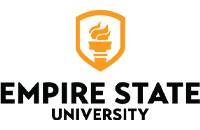How To Use EBSCOhost Databases
Dozens of the library's databases are on the EBSCOhost platform, and all of them use the same interface.
To Access EBSCOhost:
- On the library home page, click 'All Article Databases A - Z'
- Click 'E' on the horizontal list of letters near the top of that page and click on EBSCOhost.
- Enter your Empire login and password.
- That will take you to a page that lists and describes all the EBSCO databases. Check off as few or as many databases as you want and click the Continue button down at the bottom.
You can also use the Article Databases list to search a single EBSCO database at a time by clicking on its name, such as Academic Search Complete, Business Source Complete, etc.
Basic Search
When you first log into an EBSCO database you will see the Basic Search box. Type your search into the box and click the Search button.

Search tips:
- Put quotation marks around any exact phrase of 2+ words (e.g.; "United States of America" or "social psychology").
- Use AND between two keywords or phrases to search for articles containing both terms. (e.g.; Sumatra and tsunami).
- Use OR between keywords to search for articles containing either term (e.g.; teaching or pedagogy).
Advanced Search
To get to the advanced search screen, click the Advanced Search link under the Basic Search box.

- Each of the three search boxes has a Select a Field pull-down menu to the right of it.
- TX (all text) - this is the same as a keyword search in Basic Search
- AU (author) - the author of the article
- TI (title) - the title of the article
- SO (source) - the title of the journal that the article is in
- SU (subject terms) - controlled vocabulary.
- Pull-down menus to the left of the search boxes allow you to join the search boxes with AND, OR or NOT.
- You can still use AND, OR, NOT, quotation marks and parentheses inside the search boxes the same way you would in Basic Search.
- By default, EBSCOhost puts an AND in between the search boxes. You can use the pull-down menus to to change it.
- Boolean-savvy users: EBSCOhost treats each search box like a giant set of parentheses.
- You can limit your search to articles that are Scholarly (Peer Reviewed).
- You can limit your search to articles that are available in full-text without having to go into other databases. (But you run the risk of never finding out about articles that you could have gotten from other databases.)
- You can limit your search to articles that were published within a certain date range
These options are also available as filters on your search results page!
Search Results List

- To the left of each search result you'll see an icon telling you what kind of document it is - article from an academic journal, article from a magazine, conference proceedings, case study, etc.
- Beneath each search result is information on how to get the full-text of the article, if available (you'll see either PDF Full Text, HTML Full Text, or Full text Finder)
- On the left side of the search results page is a blue column of options to filter your search results:
- Filter by a publication date range.
- Filter by scholarly (peer reviewed) (gets rid of magazine and newspaper articles, etc.)
- Filter by full-text (gets rid of search results that aren't in full-text in this database). Think twice before using this option because it's very easy to find out if the full-text is available in another database.
- The title of the article is a link to the Article Information page.
Article Information
Click on the title of the article to get to the Article Information page, where you will find:
- Authors, journal name, volume, issue, page numbers, publication date, etc.
- Abstract, which is a summary of the article's content. Read this before you spend too much time trying to locate or read the full-text!
- Print/Save/Export so you will have a copy of the article without having to search for it in the database again.
- A permalink, which you need to use if you want to save the link to come back to the article, or share the article with someone else. For more information about that, see How To Create a Permalink to an Article in a Library Database.
- How to cite the article in multiple citation styles. Careful with any machine-generated citation tool like this - proofread! - they often contain minor errors such as incorrect title capitalization.

